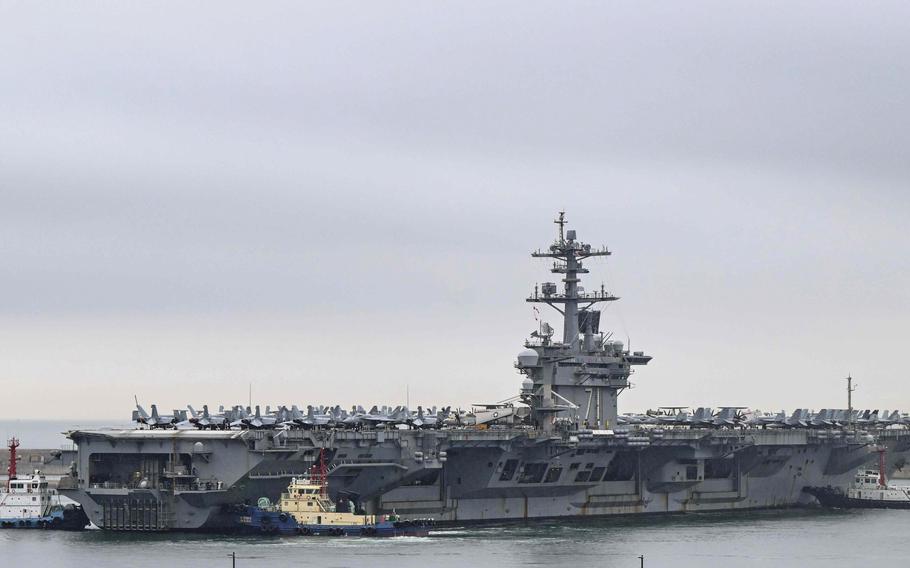
The USS Theodore Roosevelt aircraft carrier arrives in Busan, South Korea, June 22, 2024. (South Korea Navy)
CAMP HUMPHREYS, South Korea — An American aircraft carrier steamed into South Korea’s largest port over the weekend for the first time this year “as a demonstration of will” to deter North Korea’s provocations, according to the South’s navy.
The carrier USS Theodore Roosevelt and destroyers USS Halsey and USS Daniel Inouye docked at Busan on Saturday for a scheduled port call that aims to strengthen Seoul’s defense against Pyongyang, according to a South Korean navy news release that day.
The Theodore Roosevelt’s arrival precedes the start of the large-scale Freedom Edge military exercise between the United States, South Korea and Japan. The exercise is scheduled to start in the summer and will encompass land, air and sea for an unspecified duration, South Korean military officials said at a livestreamed news conference Monday. South Korean officials customarily speak on condition of anonymity.
The port call marks the first time the Theodore Roosevelt docked in Busan, roughly 200 miles southeast of Seoul, according to the South’s navy. The Nimitz-class aircraft carrier was last near South Korean waters in April, when it conducted a rare trilateral naval exercise with five other warships from South Korea and Japan.
North Korea’s state-run Korean Central News Agency on Monday condemned the warships’ arrival on the Korean Peninsula and threatened possible “overwhelming” action against the allies.
The U.S. Navy’s 7th Fleet headquartered at Yokosuka Naval Base, Japan, did not immediately respond to a request for comment by email Tuesday.
The aircraft carrier USS Carl Vinson docked in Busan on Nov. 21 as part of a combined naval exercise with Japan and South Korea. Five warships from the three countries conducted a one-day air-defense and maritime maneuver exercise.
Freedom Edge will be the first exercise of its kind between the three countries. Historical disputes between South Korea and Japan previously stymied U.S. efforts to create a combined front against North Korea; however, South Korean President Yoon Suk Yeol has vowed to make amends with Tokyo in order to deal with Pyongyang.
President Joe Biden, Japanese Prime Minister Fumio Kishida and Yoon met in August for a summit at Camp David, Md., where they pledged to renew their “bonds of friendship” through a stronger “trilateral relationship.”
“The United States unequivocally reaffirms that its extended deterrence commitments to both Japan and [South Korea] are ironclad and backed by the full range of U.S. capabilities,” the leaders said in a statement Aug. 18. “Our three countries announce today that we intend to hold annual, named, multi-domain trilateral exercises on a regular basis to enhance our coordinated capabilities and cooperation.”
Defense Secretary Lloyd Austin, Japanese Defense Minister Kihara Minoru and South Korean Defense Minister Shin Won-sik reaffirmed their intent “to deter and counter provocations effectively,” during a trilateral ministerial meeting June 2 in Singapore, according to a statement from the U.S. Embassy in Seoul.
North Korea has fired over a dozen ballistic missiles in six separate days of testing so far this year. The communist regime last fired at least 10 short-range ballistic missiles on May 30 into the Sea of Japan.